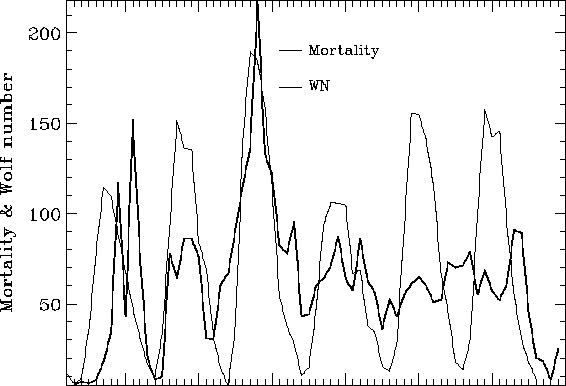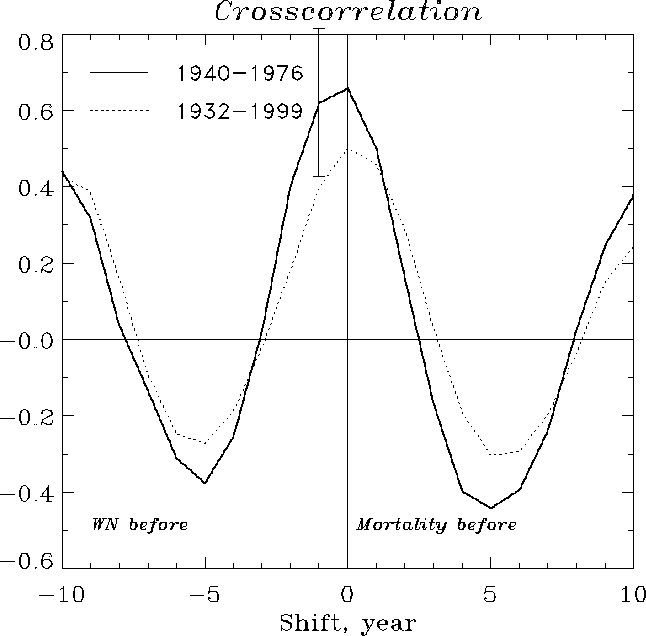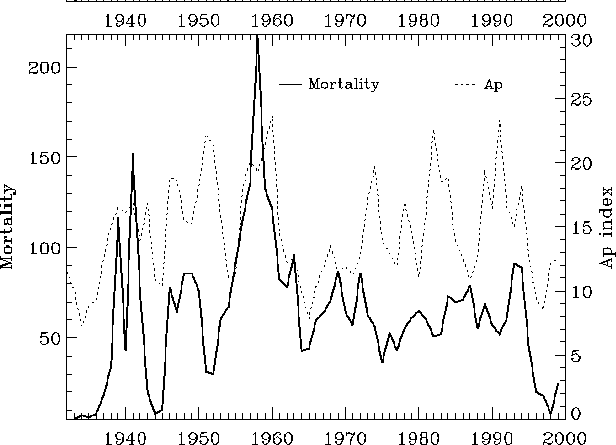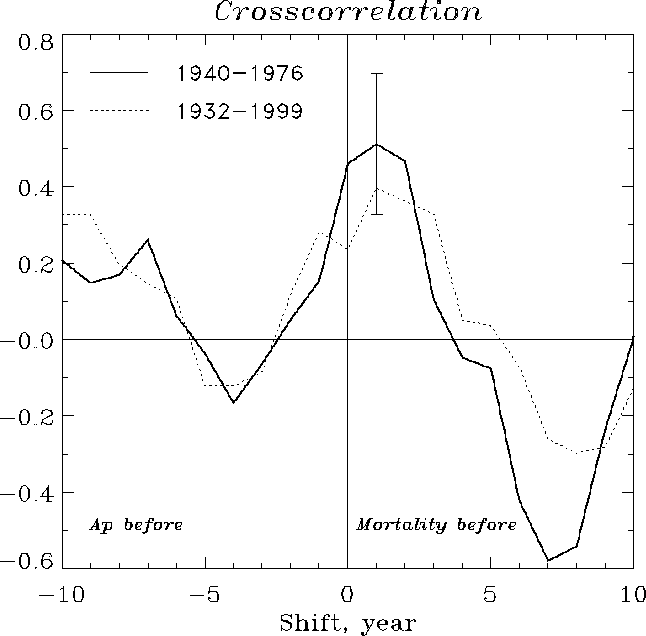Stress biologique
Sommaire
Ap Index & Wolf Number correlation risk
A demonstration of the relationship between geomagnetic storm activity and suicide
Do ambient electromagnetic fields affect behaviour?
Berk M, Dodd S, Henry M.
Department of Clinical and Biomedical Sciences-Barwon Health, University of Melbourne, Geelong, Australia.
The relationship between ambient electromagnetic fields and human mood and behaviour is of great public health interest. The relationship between Ap indices of geomagnetic storm activity and national suicide statistics for Australia from 1968 to 2002 was studied. Ap index data was normalised so as to be globally uniform and gave a measure of storm activity for each day. A geomagnetic storm event was defined as a day in which the Ap index was equal to or exceeded 100 nT. Suicide data was a national tally of daily male and female death figures where suicide had been documented as the cause of death. A total of 51 845 males and 16 327 females were included. The average number of suicides was greatest in spring for males and females, and lowest in autumn for males and summer for females. Suicide amongst females increased significantly in autumn during concurrent periods of geomagnetic storm activity (P = .01). This pattern was not observed in males (P = .16). This suggests that perturbations in ambient electromagnetic field activity impact behaviour in a clinically meaningful manner. The study furthermore raises issues regarding other sources of stray electromagnetic fields and their effect on mental health. Bioelectromagnetics. (c) 2005 Wiley-Liss, Inc.
Mortalité et Nombre de Wolf
- Populations corrélées
- A: Mortalité des plantes
- Coordonnées géomagnétiques: 46°-63°N , 46°-63° S
- B: Nombre de Wolf
- A: Mortalité des plantes
- Période
- 1932-1999: k = 0.74± 0.21
Mortalité et Ap Index
- Populations corrélées
- A: Mortalité des plantes
- Coordonnées géomagnétiques: 46°-63°N , 46°-63° S
- B: Nombre de Wolf
- A: Mortalité des plantes
- Période
- 1940-1976: k = 0.51± 18
- 1932-1999: k = 0.27± 0.13
[...] Ces considérations nous indiquent que les fluctuations de températures et les autres facteurs météorologiques ne peuvent expliquer à eux seuls les pics de mortalité. La comparaison des données sur la mortalité avec les Nombres de Wolf (WN), voir panneau du haut, fig.1 montre un degré élevé de corrélation (k = 0.74± 0.21) ainsi que pour l'index Ap présenté dans le panneau du bas. "L'index AP" est un index du champ magnétique planétaire et donne ici le niveau de perturbation magnétique entre les latitudes géomagnétiques 46° et 63° nord / sud.
Dans tous les cas, la dépendance de la réponse biologique des plantes et de leur état physiologique a été démontré en relation avec les Champs ElectroMagnétiques Faibles (EMF) [Kashulin, Pershakov, 1995].
Nous suggérons qu'un facteur héliogéophysique non identifié est impliqué dans le processus de modulation de la mortalité, et sa variation est mieux corrélée à celle du Nombre de Wolf qu'à la perturbation magnétique (index Ap).
The special consideration shows that temperature fluctuations and other meteorological factors can not explain the mortality peaks. The comparison of the mortality data with Wolf numbers (WN), see top panel of Fig.1, has showed a rather high level of correlation (k = 0.74± 0.21) for Ap index is presented on the bottom panel. It is a planetary magnetic index and shows the magnetic disturbance level between 46° and 63° north and south geomagnetic latitudes
In any case, the dependence of plant biological response on it physiological state was shown in relation to weak artificial EM fields effects [Kashulin, Pershakov, 1995]. We suggest that unidentified intermediate heliogeophysical factor is involved in the modulation of mortality process, and its variation matches making more to WN as compared to the magnetic disturbance index Ap
Article correspondant
Effets Heliogéophysiques sur la mortalité des plantes subartiques
REFERENCES
Breus T.K., Komarov F.I., Musin M.M., Naborov I.V., Rapoport S.I. Heliogeophysical factors and teir influence on cyclic processes in biosphere. Itogi Aviakosm Ekolog Med. 1995;29(3):19-21. Mikhail N. Zhadin (zhadin@online.stack.net) (4) EFFECTS OF VOLCANIC ERUPTIONS AND SUNSPOTS ON CLIMATE - UB News Service, 11 June 2002 On the Relationship of the Equatorial Electron Density (foF2) with Solar Soft X-ray Fluxes



